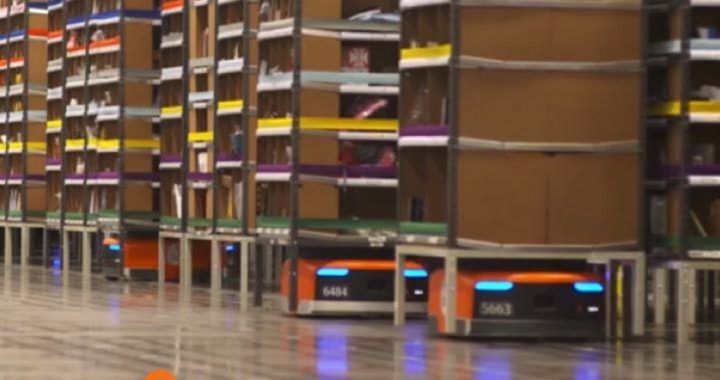
When Amazon, the largest Internet retailer in the world, purchased Kiva Systems in 2012, it paid almost a billion dollars for it; and it transformed, and continues to transform, the company. Amazon wanted the technology behind the Kiva robots that were previously being used by The Gap, Walgreens, Staples, Office Depot, Crate & Barrel, and Saks 5th Avenue. When the contracts with those companies ran out Amazon didn’t renew them.
It wanted Kiva’s technology for itself.
Today, in its more than 100 massive distribution or “fulfillment” centers, there are hundreds of thousands of Kiva robots doing the work humans used to do just a few years ago. YouTube videos of the transformation from human “pickers” to robotic pickers include this one:
The million-square-foot fulfillment center in Baltimore is typical, as Christopher Mims explained in the Wall Street Journal:
Amazon’s one-million-square-foot distribution center in Baltimore is a massive fulfillment machine. Stand at one end of the warehouse, and its titanium-white scaffolding and seemingly endless conveyor belts disappear at a vanishing point that is, somehow, within the building.
The machine is a dazzling combination of chutes, ladders, rollers and 11 miles’ worth of conveyor belts. Customers’ orders move from shelving into bins and from bins into boxes as they travel via the machine straight into delivery vans, passing by stationary workers at various points along the way.
Humans are rarely required to move around here. It’s much faster, and cheaper, to have stuff brought to them.
Each fulfillment center can process up to a million customer orders every 24 hours, with scarcely a human in sight. Artificial Intelligence (AI) informs a Kiva robot where the product is located and the robot, resembling oversize Roombas, scoots to that location, slides under a stack of shelving containing the customer’s product, and moves it to a human worker. The picker then retrieves the product, places it in a bin which is then carried on a belt to another human who packages the item, seals the box, and sends it off to shipping.
This saves each human picker about 10 miles of walking every day, and the company millions of dollars. It’s estimated that those “fulfillment” costs have been reduced by 20 percent, putting enormous pressure on its competitors, some of whom are disappearing (think Sears) or have already disappeared (think Borders).
The AI-informed robots can’t do the picking, placing, or packing, so humans must do that part. But Kiva, now called Amazon Robotics, is working on that.
At present Amazon employs 575,000 people, up from 340,000 just a year ago. As it savages its competition, it will continue to add new people just as fast as they can build new fulfillment centers. Rather like Walmart, Amazon seeks to place its centers near high population density centers to meet the demands of its growing customer base.
Ocado, the British only-online grocery supermarket, isn’t so proprietary about its technology:
In May this year it happily signed an agreement with Kroger (the country’s largest supermarket chain and its second largest retailer behind Walmart) to use its automated delivery technology to build up to 20 of its own fulfillment centers.
As Mims explained:
Ocado’s system takes a fundamentally human and Byzantine process — receiving shipments from food manufacturers, stocking and restocking a warehouse, assembling customers’ orders and placing them into baskets, scanning them and packing them into bags — and automates it to an unprecedented degree.
It took 18 years and many iterations to create this system, which has enabled Ocado to quickly deliver groceries to a customer’s front door for about the same price as they would cost at the store.
Both companies are experimenting with the next logical progression: delivery “pods” that take the customer’s order from the center to their home or office. Dallas has just approved a pilot program for pods, 26 inches wide and 48 inches high, which operate at a maximum speed of 5 mph. The Dallas Mobility Solutions, Infrastructure and Sustainability Committee was persuaded that, if successful, a complete rollout would reduce the number of manned delivery vehicles on the roads, cutting both congestion and pollution. A pod would arrive at its destination, a code to open it would be sent to the customer who would open it and retrieve his order. The pod would then return to the fulfillment center.
The next step in that technology is to let the customer order up an empty pod, much like a passenger would order an Uber pickup, place in it the package he wants shipped elsewhere — all paid for and managed online.
As this technology transforms the fulfillment business, physical geographical locations are becoming dinosaurs. Once in place they can’t be moved and are costly to maintain and upgrade with new technology. And so Amazon and its competitor Walmart are moving to the cloud, literally. As Mims explains:
A fully-automated warehouse is just the beginning. Amazon and Walmart have patented blimplike warehouses that will float 1,000 feet in the air, armed with drones ready to deliver toothpaste and toilet paper to your doorstep, as if they were files. Welcome to the physical cloud.
Image: Screenshot of Amazon Robotics ad
An Ivy League graduate and former investment advisor, Bob is a regular contributor to The New American magazine and blogs frequently at LightFromTheRight.com, primarily on economics and politics. He can be reached at [email protected].



